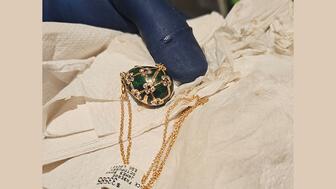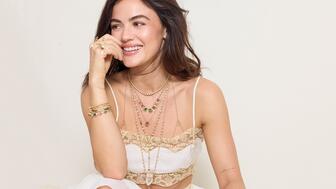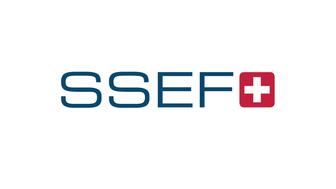The couple pleaded guilty to concealing at least $127 million in cash transactions at its precious metals businesses.
Q&A: 10 Questions with Jeffrey Cohen
The president of Citizen Watch Company of America talks distribution, Disney and the future of watches in a digital world.

Basel--Citizen, which started out as the Shokosha Watch Research Institute in 1918, is celebrating its 100th anniversary this year.
To mark the centennial, the Tokyo-based company introduced a special collection of nine limited-edition Eco-Drive watches at Baselworld and also announced that it has inked a partnership with Disney parks in the United States.
At the show, National Jeweler sat down with Jeffrey A. Cohen, president of Citizen Watch Company of America, for a one-on-one interview covering distribution, Disney and the future of wristwatches in a digital world.
This interview has been edited for length and clarity.
National Jeweler: Can we talk a little bit about your distribution--independent jeweler vs. chain vs. department store vs. online through Citizen.com?
Jeffrey Cohen: Sure. Essentially, our distribution is pretty equal, it’s basically a third, a third, a third [independents, chain jewelers and department stores]; this is no secret. We have a very strong balance of distribution.
CitizenWatch.com is really just our flagship. We use that to let the consumer have an opportunity if they’re up at night and they want to buy right from the brand, we allow them to get a different type of experience there. But primarily our distribution is the wholesale retailer and the mom-and-pop--that’s really the business that we’re supporting for the future.
It really hasn’t changed that much, though there’s been some contraction.
NJ: And this is the distribution model you want to stick to even though there’s more and more emphasis on online sales and omnichannel?
JC: We’re giving the tools and the support to the retailers; we’re very progressive there. We give them all the things that they need to do a lot of business online within their own store and outside their store. The omnichannel—you know, purchase online, pick up at store—all these different things are available to them.
We have a whole asset management system where it’ll give them all the assets [social media images and copy, email templates, banner ads], and it’s a great way to control the brand image too because we’re using our footprint, our image and it’s consistent throughout the world.
NJ: One of the struggles of the independent jeweler today is the restrictions some brands place on their products being posted on the jeweler’s website. The brand’s argument in many cases is, “We can’t control the brand messaging on 500 different websites, so we’d rather
JC: That’s an excuse. There are ways to control all your touchpoints and all online channels. If you have control over your overall distribution, and you have control of the doors that you’re selling in, there’s a way to do that. It’s just people don’t want to make the investment in the brand assets that a company like Citizen does to make sure there’s consistency.
We want people to be able to enjoy making sales either in the stores or on their dot-com site. You have your head in the sand if you’re not playing into that hand.

NJ: Citizen just announced a partnership with Disney. Can you tell me a little bit about exactly what that’s going to entail?
JC: We’re the official timepiece of the Disney parks. It’s a very big leap forward for the company because it really puts a best-in-class organization together with us. And we’re going to be involved in all the parks and all the clocks, all the FastPass clocks. It’s a collaboration that’s never been done in the watch category, for sure not like this, to this extent. And it’s not just about making watches to sell them in the parks, this goes much further, it cuts across three generations of people and it’s a wonderful experience to have.
They (Disney) don’t just partner with anybody. They want a brand that’s been here and they want something that’s going to be here for many years to come too. You’ve seen a lot of companies come and go … they do their research in a big way on brands and what the consumer feels about that brand.
NJ: You mentioned there’s a lot of brands that come and go in this industry. What in your opinion makes for a sustainable brand, particularly today when there’s so much competition for consumers’ attention?
JC: We get up every day and we say, this is our first day. How do we look forward into the future? We’re always looking forward—we never use the word since. You see a lot of people in this hall (at the Baselworld show), that’s what they do. We always look into the future, we look for innovation, we look for what’s next—what’s the next big thing and what’s the next big idea. And we try to really reach new heights to try to get to that next level. So it’s always moving forward, always going ahead and that’s where the “Better Starts Now” strategy came from. We really have a forward-looking vision.
I think everybody’s always looking back, looking in the rearview mirror and then trying to look sideways. We look straight ahead and we continue to look one step ahead of everybody else. It’s really the philosophy for us. And that’s fabric of our company, that’s why we’re successful and that’s why we’ll continue to be successful.
NJ: What do you think is the biggest challenge for the watch industry right now? When we talk about the diamond industry, the main concern is generating interest among millennials. Do you think the watch industry faces the same challenge?
JC: No, I think it’s very different, I think actually wrist share in general is up at an all-time high, people don’t realize that. People are wearing a lot of different things on their wrists.
The market’s big. We see it as an opportunity because people are using watches more as wardrobing than ever before.
It’s really become a way of people expressing themselves. It’s not something that people just [discard], like they buy a T-shirt, they buy blouse, and it ends up a year later in the drawer. You know they’re handing their watch down. These things are sustainable.
You see also a lot of other companies just really going off brand and going into the gadget business or going into things that just are not sustainable.

NJ: And so you think people will still be wearing watches 10 to 20 years from now, even though they can see the time everywhere including on their smartphone?
JC: Absolutely, absolutely.
You know when the smart phone came out, you got watches for which market share increased quite a bit for our company. Again, it’s about wardrobing and it’s about expressing yourself, who you are. That’s the way it is. I think the watch category now is hotter than it’s ever been.
NJ: Why do you think that is?
JC: I think the economy’s strong, I think people are more open-minded to trying new things. And if you’re bringing new things to them and you’re bringing things that are [sustainable], they’ll buy it. Obviously, the consumer is not as brand loyal as they used to be, this younger generation. You have to make sure that you give them a reason why you want them to feel good about Citizen; we do that. We do that through the products, the product speaks for itself. I’m confident in that.
And communication and alliances like this [one with Disney] that are really getting into their soul and gets into their emotional connection are very, very important. It’s a different way of hitting them. We need to continue to do that and become part of their life. You want them to enjoy the brand as they continue to grow up and, hopefully, they’ll be multiple purchasers. And we’re seeing that. We see a lot of people, once they get hooked on Eco-Drive, wow.
NJ: What else can we expect from Citizen for its 100th anniversary? Is there anything else forthcoming that you can tell us about right now?
JC: I could just say that for the start of the next 100 years, you’re going to see over-the-top innovation in this company, in the watch industry. We believe that we are well-poised to take the traditional market share in watches to a totally different level in the next five years. We have a lot of things we’re working on with R & D and they’re going to be from the heart of the company. We’re not going to be influenced by outside sources, but we are going to talk to the consumer and understand what’s important to them to make sure we’re delivering on that. So you’ll see product that will be innovative.
And you’ll see us aligning ourselves more with the younger generation to make sure that they grow up in the brand and we have something for them to get excited about.
NJ: To wrap up, can you share your final thoughts on the watch market in 2018 and going forward?
JC: I think it’s going to be a good year for the watch business, certainly for our company. I think we have a lot of differentiation, that’s what it’s all about—bringing new ideas to the marketplace and if you have those ideas and you continue to market and advertise and be authentic, you’ll win. We feel like we’re going to have a very strong year.
The Latest

Consumers shared concerns about prices, inflation, tariffs, trade, and politics in the survey’s write-in response section.

In February 2026, the auction house will move its headquarters to the former Steinway Hall, a neoclassical landmark on Billionaires’ Row.

How Jewelers of America’s 20 Under 40 are leading to ensure a brighter future for the jewelry industry.

The new show will take place Jan. 23-25, 2026.


The former BHP Billiton leader and Gemfields chairman is remembered for his influential leadership throughout his 50-year mining career.

The LVMH-owned brand has partnered with the costume design union to revamp its award for 2026.

Roseco’s 704-page catalog showcases new lab-grown diamonds, findings, tools & more—available in print or interactive digital editions.

The luxury titan inked a deal to acquire an initial minority stake in the jewelry manufacturer with a pathway to full ownership by 2032.

The company’s curation of unsigned vintage and estate jewelry debuted at the Bloomingdale’s in Costa Mesa, California.

In the recent multi-shipment seizure, CBP also found counterfeit Audemars Piguet, Moncler, and Chrome Hearts items.

Helzberg’s Chief Retail Officer Mitch Maggart shared details about its tests of a new store concept rooted in an elevated luxury experience.

Jewelers of America execs and National Jeweler editors discuss tariffs, the sky-high gold price, and the engagement that broke the internet.

The luxury goods company said founder Ippolita Rostagno will remain at the brand’s helm.

Laura Burdese, who joined the Italian luxury brand in 2022, will take on the role in July.

The National Jeweler editors revisit the most noteworthy industry happenings and design trends from 2025.

Need a gift for the cat lover who has everything? Look no further than our latest Piece of the Week.

It purchased the “Grosse Pièce,” an ultra-complicated Audemars Piguet pocket watch from the ‘20s, for a record-breaking price at Sotheby’s.

The lab-grown diamond grower now offers custom engagement and fashion jewelry through its Kira Custom Lab Jewelry service.

Chandler got his start at Michelson Jewelers and has served as DCA president and CEO since 2001. He will retire at the end of the month.

Sponsored by Digital Monitoring Products

The special-edition egg pendant ingested in a New Zealand jewelry store was recovered after a six-day wait.

Associate Editor Natalie Francisco plays favorites with Piece of the Week, selecting a standout piece of jewelry from each month of 2025.

The “Love and Desire” campaign is inspired by the magic that follows when one’s heart leads the way, said the brand.

Two awardees will receive free tuition for an educational course at the Swiss lab, with flights and lodging included.

Berta de Pablos-Barbier will replace Alexander Lacik at the start of January, two months earlier than expected.

Sotheby’s held its first two jewelry sales at the Breuer building last week, and they totaled nearly $44 million.


























